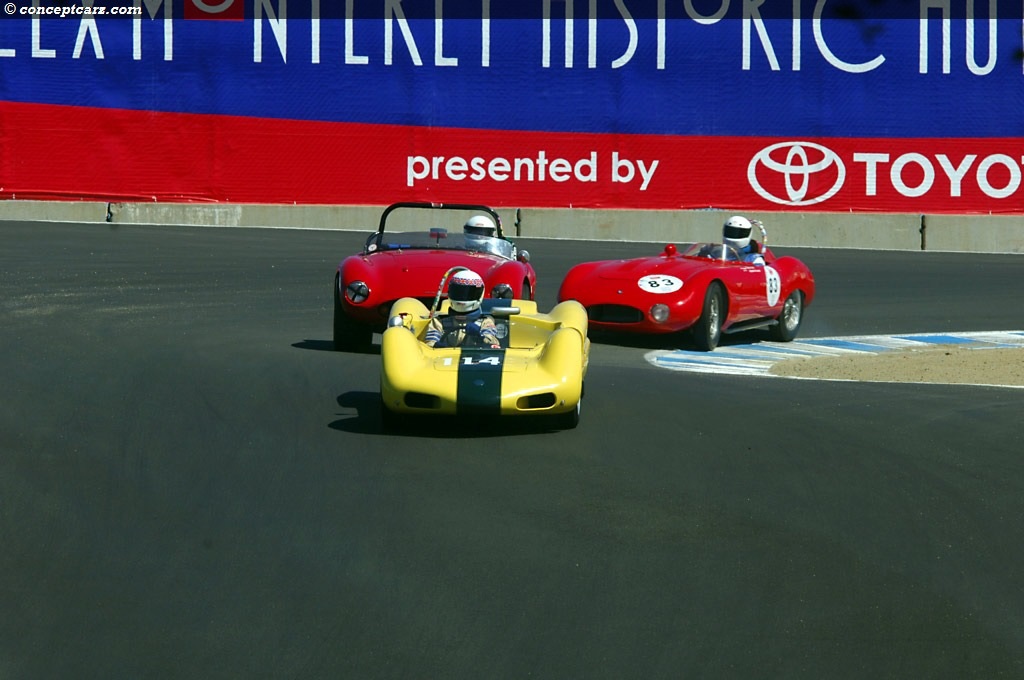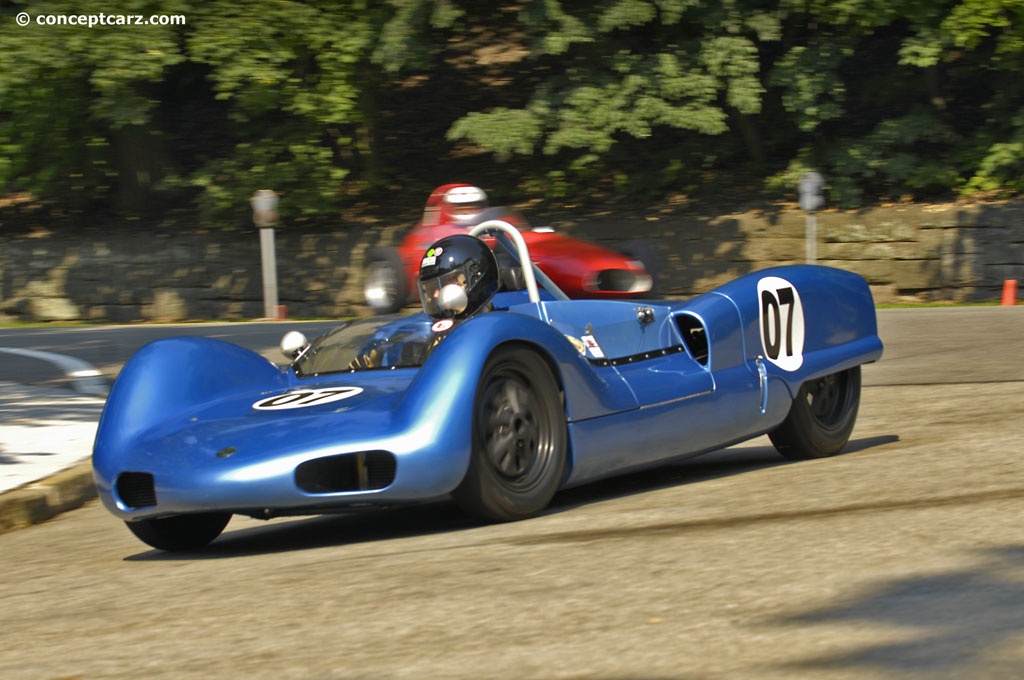The early Elva racecars were more crude, utilitarian, and conventional than they were sophisticated, complex, and cutting edge. This is understandable considering company founder Frank Nichols's background was as a mechanic and garage owner rather than a racer (although he did have some racing experience). One of Frank's mechanical engineers was 'Mac' Witts, who had created an 'inlet over exhaust' conversion for the Ford 100E engine. Since Frank was a talented businessman, he recognized an opportunity to promote the 'inlet over exhaust' conversion and had it installed in his custom-made CSM racecar. His business sense told him there was a market and demand for sports racing cars, and soon the 'ELVA' was born. The name 'ELVA', for 'ell va', means 'she goes.' Frank chose to use the name after a friend watching the CSM perform commented: 'Elle va!' in French. 
Roadster
Chassis #: 60/14
View info and historyThe early Elva's of the mid-1950s provided the necessary cash flow and the learning experience to establish a business and to prove there was a market for a low-priced alternative race car. More sophisticated Formula Juniors and sports cars followed. In 1958, Elva introduced a road-going car called the Courier. Chuck Dietrich was the United States distributor for Elva, helping them expand the business to a wider audience. Despite the company's success and popularity, the Elva Company experienced financial problems during the late 1950s and early 1960s. The failure and bankruptcy of the U.S. distributor forced Elva to reorganize the business. The Trojan company was tasked with the construction of the road-going Courier while Nichols concentrated on building race cars.One of the first products to emerge from the newly re-organized Elva company was the MK VI rear-engined sports car, the first of the modern ultra-low 'lay down' sports racers. It had a similar chassis layout to the Elva Type 300 Formula Junior, with a steel spaceframe chassis, a 1,100cc Coventry Climax engine (most examples were fitted with this engine), and a design by Keith Marsden. The aluminum floor acted as a stressed member, further strengthening the spaceframe chassis. It had a fully independent suspension setup with drum brakes and 15-inch wheels on all four corners. It wore a lightweight fiberglass body that was slippery and had a very low overall height, with split air intakes in the front. 
Roadster
Chassis #: 60/14
View info and historyThe Elva MK VI made its competition debut at Brands Hatch on Boxing Day, 1961, driven by Chris Ashmore, finishing second behind Graham Hill in a Ferrari 250 TRI/61. Total production of the Elva MK VI reached approximately 28 examples with most being sent to the United States where new importer Carl Haas was responsible for distribution. These 1.1-liter sports racers were popular in the 'CM' and G-Modified class and often the favored competitor, but this eventually changed when Lotus introduced the Type 23 which had a more powerful Ford-based engine. The Elva MK VI continued the company's reputation for easy maintenance, competitiveness, and reliability. Many American racers such as Mark Donahue got their competitive start in Elva cars. In 1963, an Elva MK VII (with a Porsche engine) finished 1st at the Road America 500, beating Cobras, Ferraris, and other large-bore automobiles. Elva would later build racing chassis for Porsche and the early McLaren V8 cars, including for the CanAm racing series. Production of the Mark VI began in December of 1961 and lasted until October 1962. They provided healthy competition for the front-engined Lotus XI's, Lola Mark I's, and other 1100cc cars. It enjoyed considerable success throughout the 1962 season, before being replaced by its successor, the Elva Mark VII.
Roadster
Chassis #: 60-02Elva VI hit the silver screen when Elvis and Ann Margaret drove the car in the 1960s musical Viva Las Vegas
by Daniel Vaughan | Feb 2020

Roadster
Chassis #: 60/14
View info and history

Roadster
Chassis #: 60/14
View info and history

Roadster
Chassis #: 60-02
by Daniel Vaughan | Feb 2020
Related Reading : Elva Sports Racer History
In the year 1955, Frank G. Nichols founded the Elva sports car manufacturing company. Based in Hastings, United Kingdom, the name Elva comes from the French phrase ella va which means she goes. Unfortunately, financial problems that were caused by the failure of the U.S. distributor the Elva Company was sold to Trojan in 1961. Production was relocated to Rye, Sussex, and again in 1966 to the main....
Continue Reading >>
Continue Reading >>
Sports Racer VehiclesSimilarly Sized Vehicles
Similarly Sized Vehicles
from 1962
1962 Elva MK VI Vehicle Profiles
Recent Vehicle Additions
Related Automotive News
Bruce McLaren's 'Buried Treasure' Unearthed After 57 Years
Legendary Jolly Green Giant The Very First McLaren Badged Car, Revealed at Bonhams
One of motor racings most legendary classic sports-racing cars, Bruce McLarens 1964 Cooper-Zerex-Oldsmobile Jolly Green Giant – which became something of...

FORMER BTCC STAR ANTHONY REID TO RACE ARRINERA GT IN 2017 AS BUILD SLOTS GO ON SALE 25/11/16 from Arrinera Racing Print this page Add this release to Your Downloads
Scottish veteran excited by Hussarya GT following test drives
Successful test sessions at UK circuits end development
Build slots for 2017 now on sale
Reid plans to race Polands new GT contender during 2017 seas...

1967 Can-Am Road America: The Beginning of the 'Bruce and Denny Show'
While Formula One will be forever considered the pinnacle of motorsport, from a period between 1966 and 1986 there existed a series that would likely be the closest to anything goes as any motor racing series could truly get. Based upon the FIA Group...

1962 Monaco Grand Prix: McLaren Carries the Cooper Flag back to the Top
By the beginning of the 1962 Formula One season Jack Brabham had left Cooper to form his own racing team. It seemed the glories days of the double World Championship were well and truly behind them. However, left in Brabhams stead would be a man very...

1961 Targa Florio: Porsche Dominance, Ferrari Victorious
The first race held on the island of Sicily that included an automobile would take place between the car, a bicycle and a horse. Although the gentleman on the bicycle would drop out rather early due to leg cramps constantly going up and down on the mountainous...

























